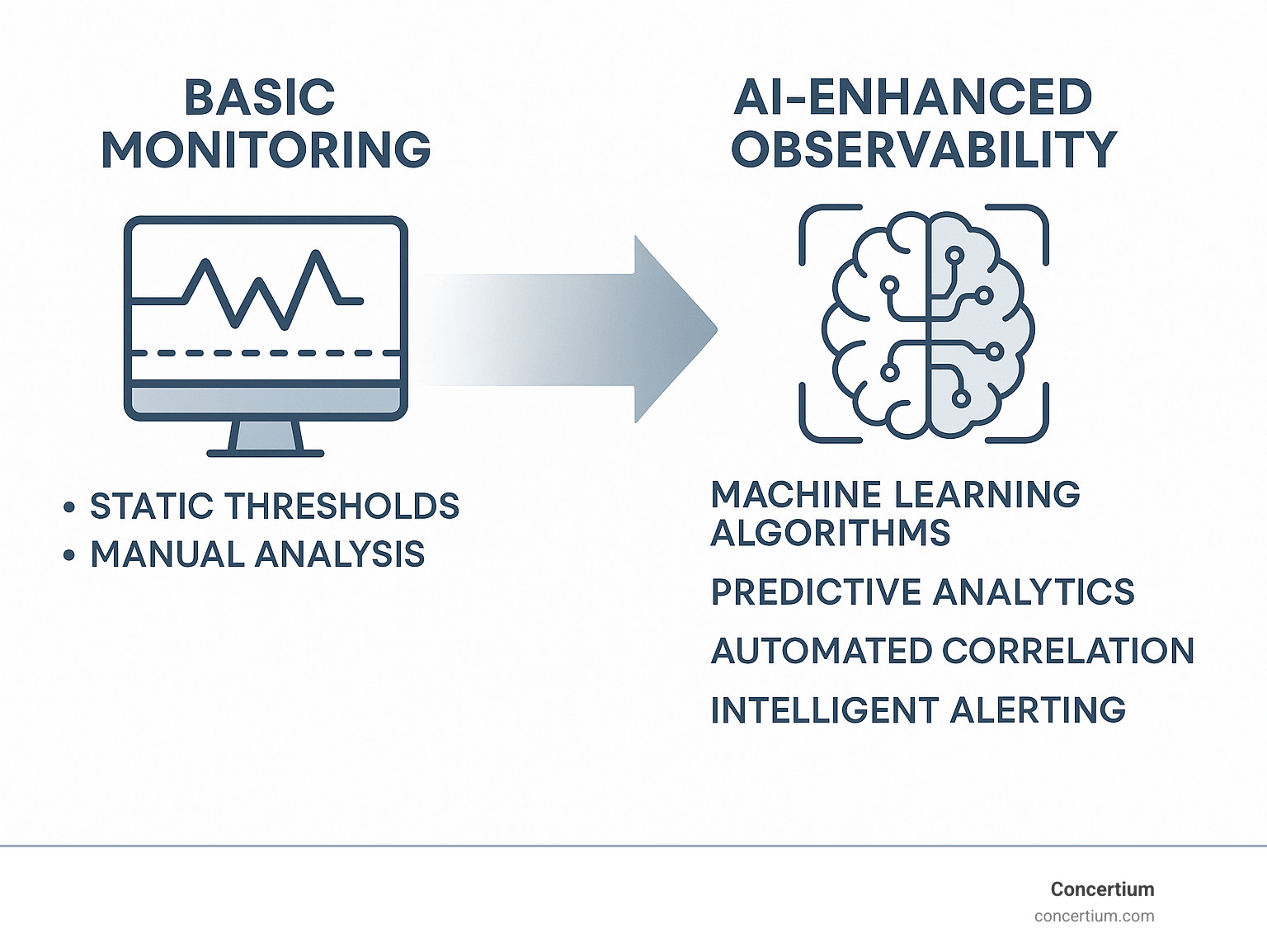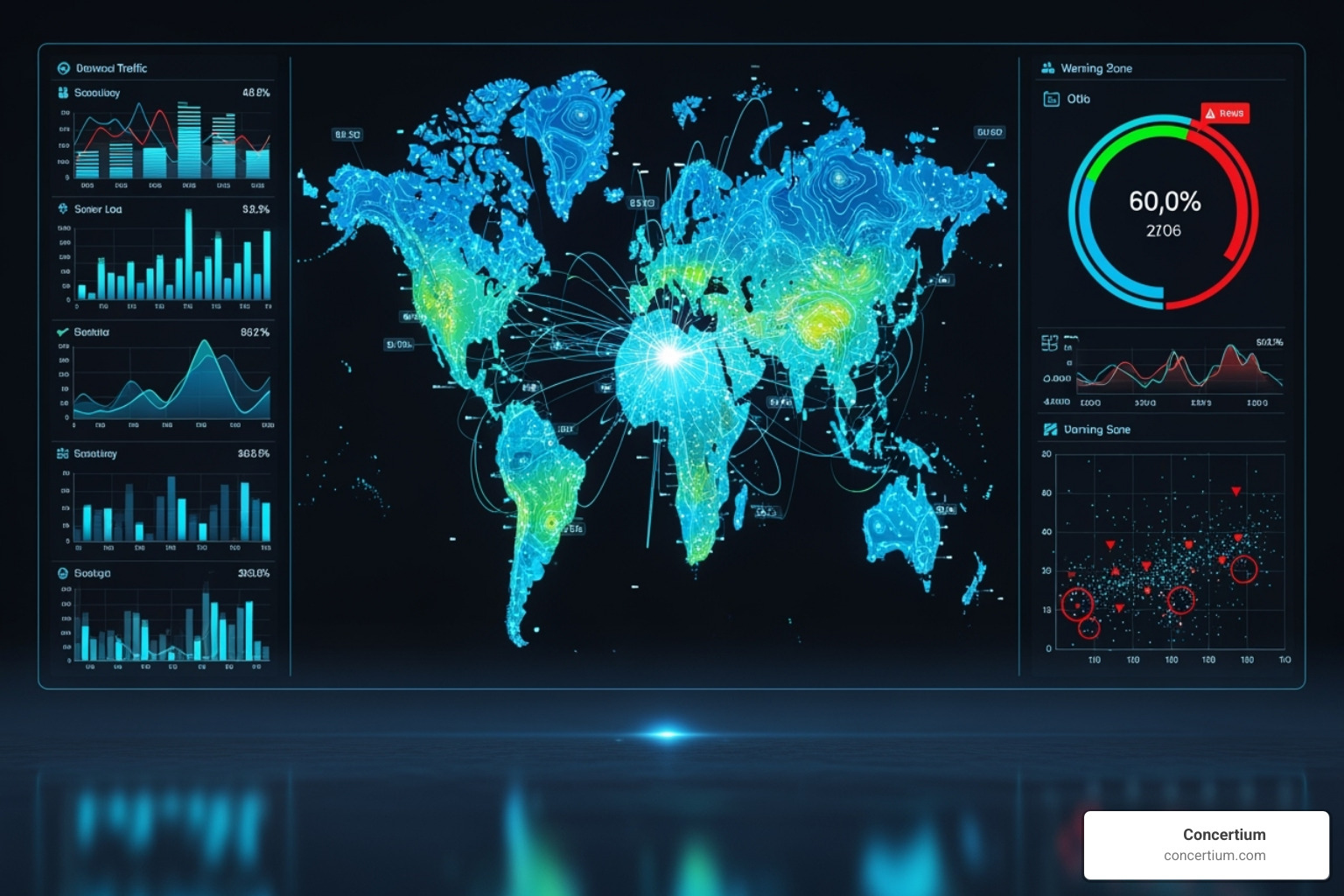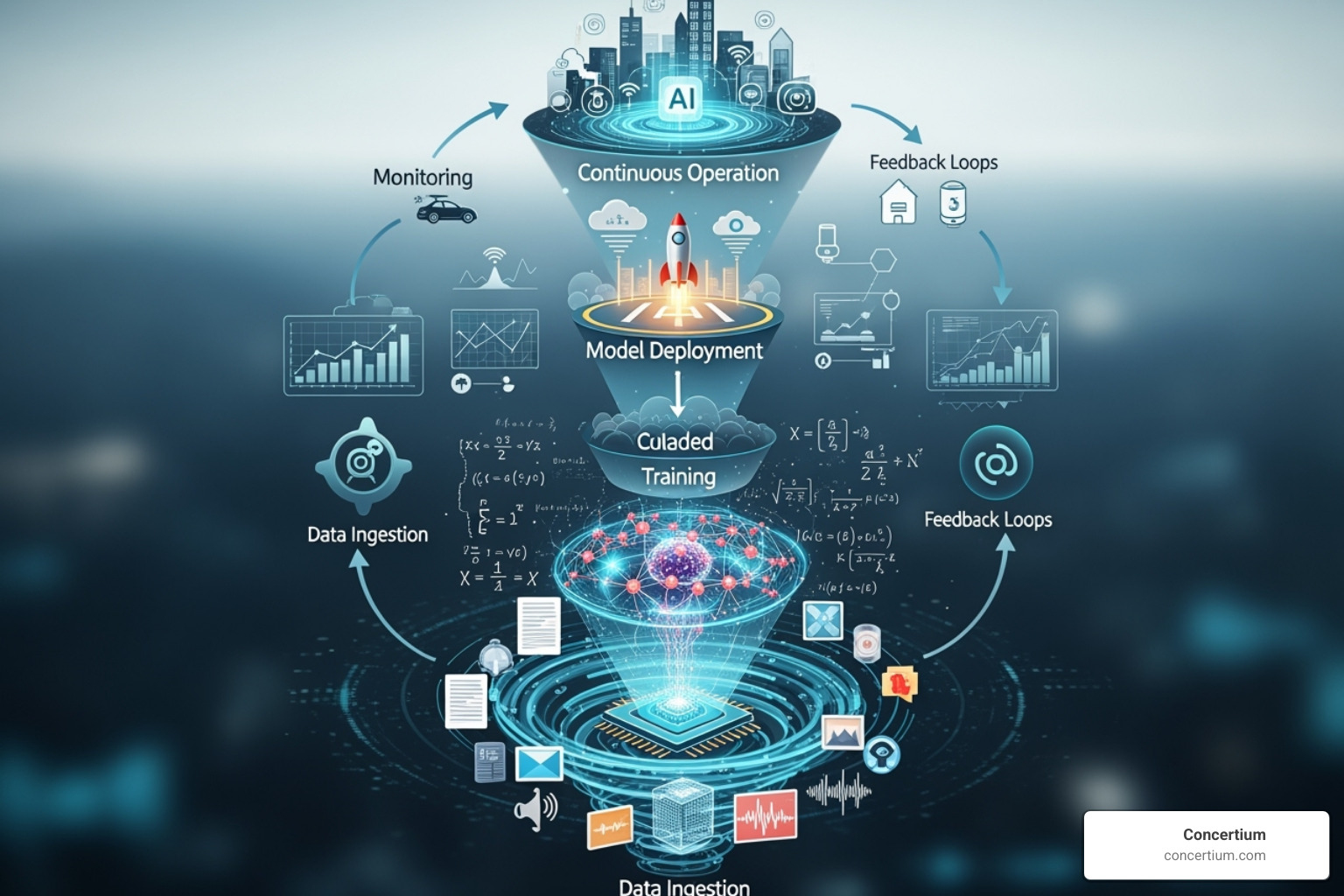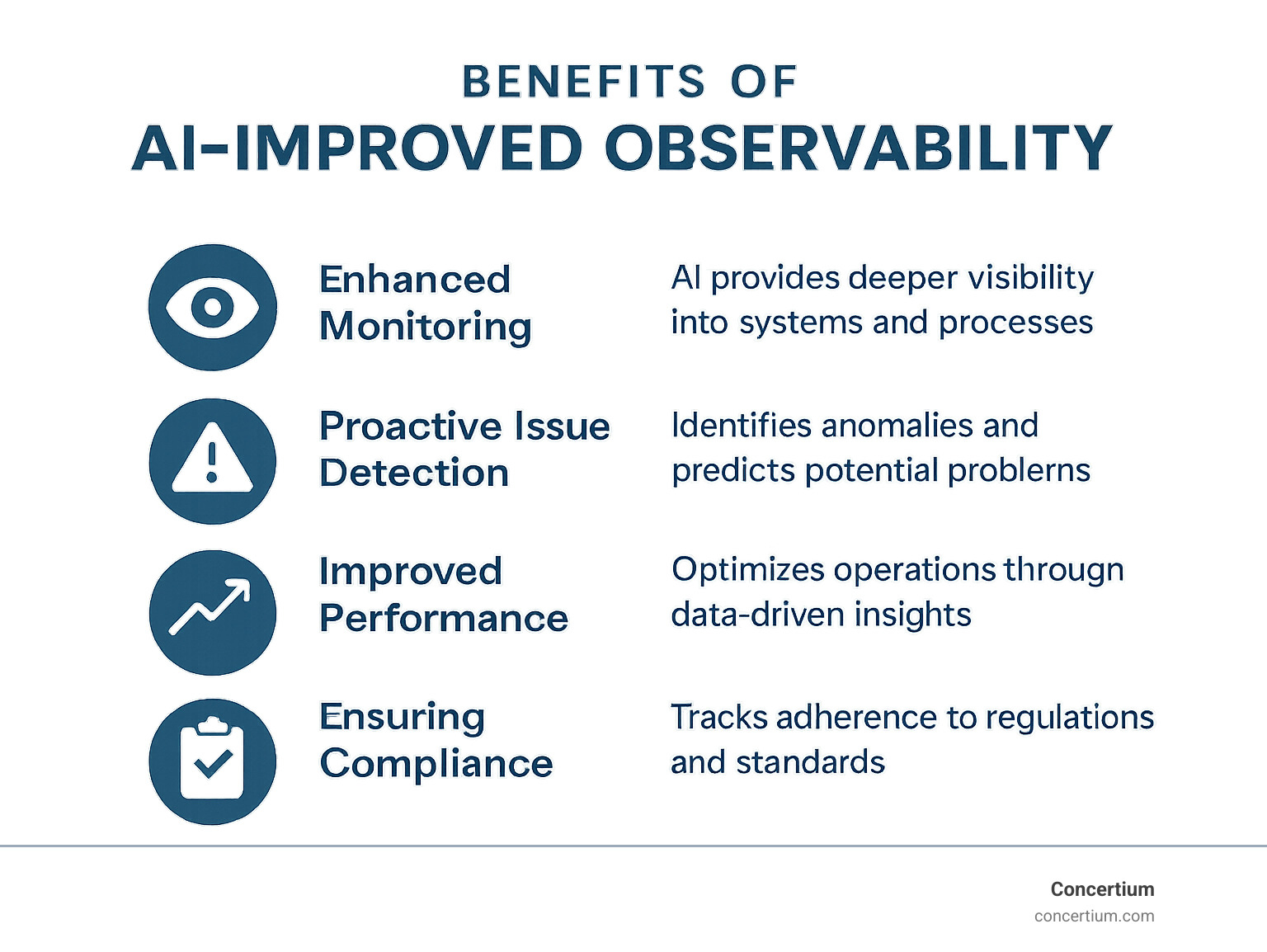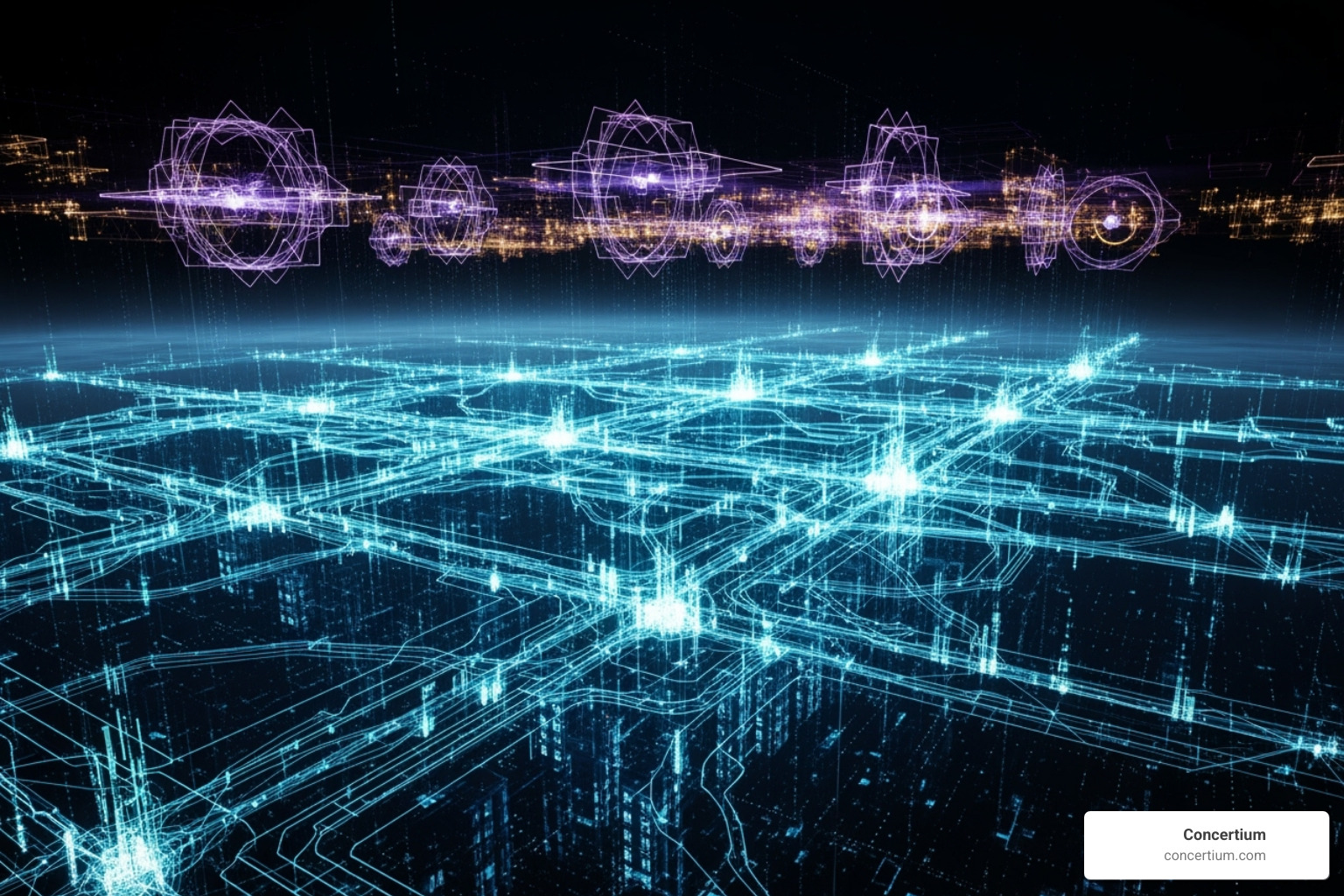AI-enhanced observability combines artificial intelligence with traditional monitoring to provide intelligent insights into complex IT systems. Unlike basic monitoring that relies on static thresholds, AI-enhanced observability uses machine learning to automatically detect anomalies, predict failures, and correlate data across your entire infrastructure. AI-enhanced observability is essential for understanding modern applications.
Key capabilities of AI-improved observability:
- Enhanced troubleshooting – AI-enhanced observability allows for faster issue resolution by pinpointing problems quickly.
- Automated anomaly detection – Identifies unusual patterns without manual threshold setting
- Predictive analytics – Forecasts potential issues before they impact users
- Intelligent root cause analysis – Automatically correlates data to pinpoint problems
- Reduced alert fatigue – Filters noise and prioritizes critical issues
- Natural language interfaces – Query systems using plain English
- Self-healing capabilities – Automatically responds to common issues
- AI-enhanced observability integration – Seamlessly integrates with existing IT systems for better data flow.
It’s 3:17 AM. Your phone buzzes with alerts – API error rates have spiked to 60%. You’re drowning in terabytes of logs, trying to find the needle in the haystack while your customers can’t access your services.
In a world where AI-enhanced observability is becoming standard, organizations must adapt quickly to maintain a competitive edge.
This scenario plays out in companies worldwide as traditional monitoring struggles with today’s complexity. Modern applications use thousands of microservices, containers, and distributed systems that generate massive amounts of data. Only around 10% of organizations achieve full observability today, and Mean Time to Remediation (MTTR) continues to rise despite better tools.
The problem isn’t just volume – it’s context. Traditional monitoring tools give you metrics, logs, and traces, but they can’t connect the dots across your entire system. They react to problems after they happen instead of predicting and preventing them.
That’s where AI changes everything. By analyzing patterns across all your telemetry data, AI can spot subtle signs of trouble that humans miss, predict failures before they occur, and automatically correlate events to show you exactly what’s wrong and why.
AI-enhanced observability provides a comprehensive view of system performance and health, offering actionable insights that promote efficiency.
Why Traditional Monitoring Can’t Keep Up with Modern Complexity
Remember when IT infrastructure was simple? You had a few servers, a database, and maybe a web application. Monitoring meant setting a CPU threshold at 90% and waiting for an alert. Those were the days.
Today’s IT landscape looks nothing like that peaceful past. We’re living in a world of microservices architectures, cloud-native applications, serverless functions, and distributed systems that span multiple clouds. It’s amazing what we can build now, but it’s also created a monitoring nightmare that traditional tools simply can’t handle.
Here’s what’s breaking our old monitoring systems:
Data volume has exploded beyond anything we imagined. Modern applications generate massive streams of telemetry data – metrics, logs, traces, and events flowing in 24/7. It’s like trying to drink from a fire hose while riding a unicycle. Human operators and conventional analysis tools just can’t process this much information fast enough.
Alert fatigue is killing our teams. When one small issue triggers hundreds of alerts across interconnected services, your SRE team stops trusting the system. They’re drowning in noise, missing the signals that actually matter. This is one reason why Mean Time to Remediation (MTTR) keeps climbing despite all our fancy new tools.
The siloed data problem makes everything worse. Your metrics live in one tool, logs in another, and traces somewhere else entirely. Getting a complete picture means jumping between multiple dashboards and trying to piece together a story from fragments. It’s exhausting and slow.
Manual correlation becomes a full-time job. When something breaks in a distributed system, finding the root cause means manually connecting dots across all those different data sources. You’re basically playing detective with clues scattered across different crime scenes. No wonder incident resolution takes so long.
Traditional monitoring is stuck in reactive mode. By the time you get an alert, your customers are already feeling the pain. You’re always fighting fires instead of preventing them. In today’s competitive landscape, that’s just not good enough.
Static thresholds don’t work in dynamic environments. What’s normal at 9 AM on Monday might be completely different at 3 PM on Friday. Cloud-native systems scale up and down, workloads shift, and user patterns change. Fixed thresholds either cry wolf constantly or miss subtle problems until they become disasters.
The biggest issue is the lack of context. Traditional tools might tell you what’s happening, but they can’t explain why it matters or how it affects your business. Without context, every alert feels equally urgent, and nothing feels urgent at all.
This is exactly why we need something smarter. We need systems that can think, learn, and adapt to our complex environments. We need AI-Improved Observability that turns overwhelming data into actionable insights, transforms reactive firefighting into proactive problem-solving, and gives our teams the context they need to make smart decisions fast.
The Core Capabilities of AI-Enhanced Observability
The benefits of AI-enhanced observability extend beyond technical advantages; they impact overall business performance and customer satisfaction.
Picture this: you’re sitting in your office with a mountain of data flowing in from every corner of your IT infrastructure. Metrics, events, logs, and traces (MELT) are streaming past you like a digital waterfall. Traditional monitoring would leave you feeling like you’re trying to catch raindrops in a teacup.
AI-improved observability changes everything. Instead of drowning in telemetry data, you get intelligent insights that actually make sense. It’s like having a brilliant detective who can look at thousands of clues and instantly tell you what’s really happening.
AI-enhanced observability can revolutionize how teams respond to incidents, fostering a proactive culture rather than a reactive one.
The magic happens when artificial intelligence steps in to transform all that raw data into proactive insights. Rather than just collecting information, we’re now talking about systems that can think, predict, and even take action. This is where AI and Automated Threat Detection becomes more than just a buzzword – it becomes your competitive advantage.
Smarter Anomaly Detection and Predictive Analytics
Remember those old-school monitoring systems that would scream bloody murder every time your CPU hit 90%? Even if it happened every Tuesday at 2 PM like clockwork? Those days are behind us.
Dynamic baselines are where AI really shines. Instead of rigid thresholds that treat every situation the same, AI learns your system’s personality. It knows that Tuesday afternoon spike is perfectly normal, but if the same spike happens at 3 AM on a Sunday, something’s definitely wrong.
This pattern recognition goes way beyond what human eyes can catch. AI spots those subtle warning signs – the tiny changes in response times, the gradual increase in error rates, the slight shift in user behavior patterns. These early signals let you jump into action before your customers even notice a hiccup.
With AI-enhanced observability, organizations can expect reduced downtime and improved operational efficiency.
But here’s where it gets really exciting: forecasting failures. AI can actually predict when your system might run into trouble. Maybe it notices a memory leak that’s slowly growing, or it sees disk space trending toward capacity. Based on the Role of AI and Machine Learning in Threat Detection, these predictive capabilities extend beyond just performance issues to security threats as well.
Resource exhaustion prediction becomes your crystal ball. Instead of waiting for that dreaded “disk full” alert at midnight, AI gives you a heads-up days in advance. You can scale up resources, clean up old files, or optimize processes before anyone’s weekend gets ruined.
This proactive approach through Automated Threat Detection doesn’t just save your sanity – it saves money and keeps your customers happy.
The AI-enhanced observability framework ensures that monitoring strategies evolve alongside technological advancements.
Intelligent Root Cause Analysis (RCA)
When something does go wrong in a complex distributed system, finding the root cause used to be like playing detective in a mystery novel where half the pages are missing. You’d spend hours digging through logs, trying to connect the dots between different services and components.
AI-enhanced observability turns you into Sherlock Holmes with superpowers. The AI automatically handles data correlation across all your sources. When your database starts struggling, it doesn’t just tell you about the database alerts – it connects them to the application slowdowns, the user complaints, and the downstream service errors. All in seconds, not hours.
By leveraging AI-enhanced observability, businesses can enhance their decision-making processes and minimize risks.
Pinpointing bottlenecks becomes almost effortless. AI maps out how all your microservices, containers, and APIs talk to each other. When performance takes a hit, it can trace the problem back through the entire chain of dependencies to show you exactly where things went sideways.
The dependency mapping is particularly brilliant. AI builds these dynamic maps showing how your services interact in real-time. When an issue pops up, you instantly see the blast radius – which services are affected, how the problem is spreading, and where you need to focus your attention.
This intelligent approach significantly reduces your Mean Time to Resolution (MTTR) and supports Automated Network Threat Detection by quickly identifying potential security incidents before they escalate.
Reducing Alert Fatigue and Automating Responses
If your phone buzzes with alerts so often that you’ve started ignoring them, you know exactly what alert fatigue feels like. It’s like the boy who cried wolf, but with pagers and Slack notifications.
AI-improved observability acts like a really smart filter. Instead of bombarding you with every little hiccup, it uses noise reduction to focus on what actually matters. Related alerts get grouped into single, actionable incidents. No more getting fifteen alerts for one database problem.
Intelligent alerting means the AI learns from your responses over time. It figures out which alerts you actually care about and which ones are just noise. The thresholds adjust dynamically based on context and historical data. Your 2 AM emergency calls drop dramatically.
Event correlation gives you the full story when an alert does come through. Instead of just “database slow,” you get “database slow due to memory pressure, affecting checkout process, 200 users impacted.” Now that’s actionable information.
The real game-changer is self-healing systems. For common, well-understood problems, AI can actually fix things automatically. Server running low on memory? Scale it up. Service crashed? Restart it. Simple configuration issue? Apply the fix. You wake up to a summary of what was resolved while you slept.
This automation capability ties directly into our Automated Threat Detection and Automation approach and improves our Threat Detection and Response services.
AI-improved observability transforms IT operations from constant firefighting into strategic system management. You spend less time reacting to problems and more time preventing them. Your systems run smoother, your team sleeps better, and your customers stay happy.
AI-enhanced observability is not just about monitoring; it’s about creating a deeper understanding of your systems.
Observing the Observers: Monitoring AI, LLMs, and Agentic Systems
The integration of AI-enhanced observability tools can drastically improve incident response times and overall system stability.
Here’s where things get wonderfully meta. We’ve been talking about how AI-improved observability helps us monitor our traditional IT systems. But what happens when the systems we’re trying to observe are themselves powered by artificial intelligence?
It’s like trying to watch the watchers – and trust me, it gets interesting fast.
As technology advances, the role of AI-enhanced observability in ensuring smooth operations will be undeniable.
Monitoring AI systems, especially Large Language Models and autonomous agents, is a completely different ball game. These aren’t your typical predictable applications that do the same thing every time you press a button. AI systems have non-deterministic behavior – give them the same input twice, and you might get slightly different outputs. Their performance can shift over time as models learn and adapt, making traditional monitoring approaches feel like trying to measure a cloud with a ruler.
This complexity means we need to weave observability directly into the AI lifecycle integration from the very beginning. We’re talking about observability checkpoints at every stage – from training and validation to deployment and beyond. It’s not an afterthought; it’s baked right into how we build and manage these intelligent systems.
With AI-enhanced observability, organizations can gain insights that lead to better strategic planning and operational improvements.
This approach becomes especially critical when we consider our Applications of AI in Threat Intelligence. When AI models are making security decisions, we need to be absolutely certain they’re performing as expected.
Unique Challenges of Monitoring LLMs and AI Agents
Forget everything you know about monitoring traditional applications. AI systems march to the beat of their own drum, and they bring some fascinating challenges to the observability party.
AI-enhanced observability allows for real-time monitoring, ensuring that potential issues are addressed before they escalate.
Token usage becomes a critical metric that didn’t exist in our traditional monitoring world. Every interaction with an LLM consumes tokens, and with pay-per-token pricing models, this directly impacts your bottom line. We need to track not just how many tokens are being consumed, but when and why usage spikes occur.
Then there’s prompt quality – the art and science of getting AI to understand what you really want. A poorly crafted prompt can lead to terrible responses, multiple retries, and frustrated users. Observability needs to track which prompts work well and which ones send your AI system into a confused spiral.
Investing in AI-enhanced observability is crucial for organizations looking to remain competitive in today’s fast-paced environment.
Response latency takes on new meaning with AI systems. Unlike a database query that takes a predictable amount of time, LLMs can vary wildly in their response times based on the complexity of the question, the model size, and even the current load on the underlying infrastructure.
But here’s where it gets really interesting – hallucinations. Yes, AI systems can essentially make things up, generating responses that sound perfectly reasonable but are completely wrong. Traditional error monitoring won’t catch this because technically, the system didn’t crash or throw an error. It just confidently told you that penguins live in the desert.
Model drift and data drift add another layer of complexity. Your beautifully trained model might start performing poorly as the real world changes around it. The data it encounters in production might be different from what it learned during training, causing subtle but important performance degradation.
AI-enhanced observability also empowers teams to focus on innovation rather than constantly putting out fires.
For agent decision tracking in autonomous systems, we need to understand not just what an AI agent did, but why it made that choice. When you have multi-agent systems where multiple AI entities are interacting, the complexity grows exponentially. It’s like trying to follow a conversation at a crowded party where everyone is speaking a different language.
This specialized monitoring is essential for our Managed Detection and Response services, where AI plays a crucial role in identifying and responding to threats.
The Role of Ethics and Compliance in AI-Enhanced Observability
Here’s something that keeps me up at night (in a good way) – making sure our AI systems are not just smart, but also ethical and compliant. AI-improved observability isn’t just about performance metrics anymore; it’s about ensuring our artificial intelligence behaves responsibly.
The future of AI-enhanced observability will undoubtedly redefine how organizations approach their monitoring strategies.
Bias detection becomes a critical observability function. AI models can inadvertently learn biases from their training data, leading to unfair outcomes. We need monitoring systems that can spot when an AI system is treating different groups unfairly, even when it’s subtle.
With regulatory frameworks popping up around the world, compliance monitoring is becoming essential. From GDPR to emerging AI-specific regulations, we need observability tools that help us prove our AI systems are operating within legal boundaries. It’s not enough to build great AI – we need to show that it’s playing by the rules.
Data privacy takes on new dimensions when AI is involved. These models process enormous amounts of data, much of it sensitive. Our observability systems need to ensure privacy is maintained throughout the entire AI lifecycle, from the moment data enters the system until the final output is delivered.
Explainable AI is where observability really shines. When an AI system makes a decision, especially in critical applications, we need to understand why. Our observability tools help peek inside that “black box” to understand decision paths, feature importance, and model behavior.
This commitment to ethical AI monitoring is deeply woven into our approach to Compliance and Risk Management. Because at the end of the day, powerful AI needs responsible oversight – and that’s where thoughtful observability makes all the difference.
Practical Applications and Business Benefits
AI-enhanced observability will play a pivotal role in shaping the next generation of IT operations.
Let’s get real for a moment. All this talk about artificial intelligence and advanced monitoring sounds impressive, but what does it actually mean for your bottom line? How does AI-improved observability translate into dollars saved, customers retained, and sleepless nights avoided?
The impact of AI-enhanced observability on customer satisfaction cannot be overstated, as it leads directly to improved service delivery.
The truth is, the business impact goes far beyond just keeping your systems running smoothly. When you implement AI-improved observability, you’re not just upgrading your monitoring tools – you’re changing how your entire organization operates.
Think about it this way: every minute your systems are down costs money. Every frustrated customer who can’t access your service might switch to a competitor. Every time your team spends hours hunting through logs instead of building new features, you’re falling behind. AI-improved observability tackles all of these challenges head-on.
Increased operational efficiency becomes immediately apparent when your teams stop playing detective with every incident. Instead of manually correlating data from dozens of different tools, AI does the heavy lifting. Your engineers can focus on what they do best – innovating and building great products – rather than firefighting.
Reduced downtime might be the most obvious benefit, but it’s also the most impactful. When AI can predict a database is about to run out of memory three hours before it happens, you can take action during business hours instead of scrambling at 2 AM. Your customers never even know there was a potential problem.
Incorporating AI-enhanced observability into your strategy is not just a trend; it’s a necessity for future success.
The ripple effect on customer experience is profound. Fewer outages mean happier users. Faster problem resolution means less frustration. When your systems perform consistently, trust builds naturally. And we all know that customer retention is far less expensive than customer acquisition.
But here’s where it gets really interesting: cost optimization. Predictive analytics doesn’t just prevent expensive emergencies – it helps you make smarter decisions about resource allocation. Why pay for servers sitting idle when AI can predict exactly when you’ll need to scale up or down? This kind of precision in resource management can save thousands of dollars monthly for mid-sized companies and millions for enterprises.
Proactive maintenance changes the game entirely. Instead of waiting for things to break, you’re fixing them before they become problems. It’s like getting your car serviced based on engine diagnostics rather than waiting for it to break down on the highway. Planned maintenance is always cheaper and less disruptive than emergency fixes.
AI-enhanced observability is key to understanding the big picture in system performance.
This comprehensive approach also strengthens your Cybersecurity Risk Management efforts. When you can spot unusual patterns quickly, you’re not just catching performance issues – you’re identifying potential security threats before they escalate.
[LIST] of Key Business Benefits
Here’s what you can expect when you implement AI-improved observability:
-
- Improved system reliability – More uptime, consistent performance, and systems that actually work when your customers need them
- Faster incident resolution – Problems get solved in minutes instead of hours, reducing business impact
- Optimized resource allocation – Smart scaling decisions that save money and improve efficiency
- Improved security posture – Better threat detection and faster response to potential breaches
With AI-enhanced observability, businesses can stay ahead of potential threats and make informed decisions.
- Data-driven decision making – Clear insights that help you make smarter business choices
Implementing AI-Improved Observability: Key Steps
AI-enhanced observability ensures that your organization is equipped with the tools needed for modern challenges.
Ready to start your journey toward smarter observability? The key is taking a methodical approach that builds on solid foundations.
Data unification comes first. You can’t have intelligent insights without good data. This means adopting standards like OpenTelemetry to bring together all your metrics, logs, and traces in one place. Think of it as organizing your toolshed – everything needs a proper place before you can find what you need quickly.
The quality of your data matters just as much as the quantity. Standardizing formats and adding contextual metadata might seem tedious, but it’s what makes AI analysis truly effective. Garbage in, garbage out – it’s an old saying that’s especially true with machine learning.
Starting with focused use cases prevents you from getting overwhelmed. Pick one persistent problem – maybe that API that always seems to slow down during peak hours, or those alerts that wake up your on-call team every weekend. Solve one problem well, demonstrate the value, then expand from there.
Human-AI collaboration is the secret sauce. AI doesn’t replace your experienced engineers – it makes them superhuman. Your team’s domain expertise guides the AI, while the AI handles the tedious pattern recognition and data correlation. It’s like having a brilliant research assistant who never gets tired.
Feedback loops keep your AI systems getting smarter over time. When your team marks an alert as a false positive or confirms that a prediction was accurate, the system learns. This continuous improvement means your observability gets better the longer you use it.
The implementation process also strengthens your Vulnerability Risk Management capabilities. Better visibility into your systems means better security – it’s really that simple.
The bottom line? AI-improved observability isn’t just a nice-to-have upgrade. It’s becoming essential for staying competitive in a world where system complexity keeps growing but customer patience keeps shrinking.
The journey to effective AI-enhanced observability is one that yields substantial rewards and business benefits.
Frequently Asked Questions about AI-Improved Observability
Understanding AI-enhanced observability will empower teams to leverage insights effectively.
We get a lot of questions about AI-improved observability from teams who are curious but maybe a little overwhelmed by all the technical jargon. Don’t worry – we’ve all been there! Let’s tackle the most common questions we hear and break them down in plain English.
How is AI-improved observability different from AIOps?
This is probably the question we hear most often, and honestly, it makes perfect sense why people get confused. Both involve AI helping with IT operations, so what’s the difference?
The distinction between general AI tools and those focused on AI-enhanced observability is crucial for strategic planning.
Think of AIOps as the big umbrella. It’s like saying “I use technology to help run my business” – it covers everything from incident management to change management to problem resolution across your entire IT landscape. AIOps platforms try to automate and streamline all sorts of operational processes.
AI-improved observability, on the other hand, is more focused. It’s specifically about using artificial intelligence to get smarter insights from your system data – those metrics, events, logs, and traces that tell you what’s happening inside your applications and infrastructure.
Here’s a simple way to think about it: if AIOps is like having a smart assistant that helps with all your IT operations, then AI-improved observability is like having super-powered glasses that help you see and understand what’s really going on in your systems. It’s a specialized tool within the broader AIOps toolkit.
Do I need a team of data scientists to use these tools?
The ongoing evolution of AI-enhanced observability tools will redefine how organizations approach complex IT systems.
We hear this concern a lot, and it usually comes with a worried look! The good news? You probably don’t need to hire a bunch of data scientists to get started with AI-improved observability.
Most modern platforms come with AI capabilities already built in. The heavy lifting – training models, building algorithms, figuring out complex math – has already been done for you. These tools work right out of the box with smart anomaly detection, automated root cause analysis, and intelligent alerting.
To maximize the benefits of AI-enhanced observability, organizations must prioritize data quality and relevance.
Your job is more about being a good operator than a data scientist. You need to make sure the tools get good, clean data to work with. You need to configure them properly for your environment. And most importantly, you need to understand how to interpret the insights they give you and take action.
Think of it like using a modern smartphone. You don’t need to understand how the processor works or how the camera algorithms function – you just need to know how to take great photos and use the apps effectively.
That said, having someone on your team who understands data and can dig deeper when needed is definitely helpful. But it’s not a requirement to get started and see real benefits.
How can I measure the ROI of implementing AI-improved observability?
Ah, the million-dollar question! Your CFO is probably asking this one, right? The great news is that AI-improved observability offers some pretty measurable benefits that translate directly to dollars and cents.
The time savings alone can be huge. Start by measuring how quickly you can spot problems (Mean Time to Detection) and how fast you can fix them (Mean Time to Resolution). When AI helps you find issues faster and points you toward the root cause automatically, those hours add up quickly. Less time spent troubleshooting means more time for your team to work on projects that actually move the business forward.
Then there’s the alert fatigue factor. Track how many false alarms your team used to get versus how many they get now. Every false alert that gets filtered out is time your team can spend on something more valuable. Plus, when people aren’t constantly interrupted by meaningless alerts, they’re happier and more productive.
Customer impact is another big one. Measure how many issues you catch before customers even notice them. Every outage you prevent, every slowdown you fix proactively, every problem you solve before it hits production – that’s direct value to your business reputation and customer satisfaction.
The integration of AI-enhanced observability systems is a crucial investment for future growth.
Don’t forget about resource optimization. When AI helps you predict when you’ll need more server capacity or identifies underused resources, those cost savings are easy to calculate. You’re not over-provisioning “just in case” anymore, and you’re not scrambling to add capacity at the last minute.
The beauty of these metrics is that they’re concrete and measurable. You can show real numbers that demonstrate exactly how AI-improved observability is making your operations more efficient and your business more resilient.
The Future is Clear with AI-Improved Observability
Overall, AI-enhanced observability will shape the future of IT monitoring and operations.
As we’ve explored, AI-improved observability is already changing how we manage complex IT environments. But this is just the beginning. The future holds even more exciting advancements that will further blur the lines between monitoring, analysis, and autonomous operations.
We envision a future where:
- Causal AI: Beyond just correlation, AI will increasingly understand the causal relationships between events. This means it won’t just tell us what’s happening or what’s likely to happen, but why it’s happening, leading to even more precise root cause analysis and predictive capabilities.
- Digital Twins: Imagine a virtual replica of your entire IT infrastructure that constantly mirrors the real system. AI can then simulate scenarios, test changes, and predict outcomes in this digital twin before they’re applied to the live environment, enabling unparalleled proactive management.
- Autonomous Remediation: While we’re already seeing glimpses of self-healing systems, the future will bring more sophisticated autonomous remediation. AI agents, powered by advanced LLMs, will not only detect and diagnose issues but will also be able to autonomously implement complex fixes, manage changes, and optimize configurations without human intervention for a wider range of problems.
- Generative AI Interfaces: Interacting with our observability tools will become as natural as chatting with a colleague. Generative AI interfaces will allow engineers to query complex data, get real-time insights, and even draft post-mortems using natural language, significantly reducing cognitive load and accelerating troubleshooting. The shift from categorized web searches to Google’s single search bar is a great analogy for the simplification brought by AI in observability.
- Ethical AI and Compliance by Design: As AI systems become more autonomous, ethical considerations and compliance will be baked into their core design. Observability will play a critical role in continuous monitoring for bias, fairness, and adherence to evolving regulatory frameworks.
The journey towards full observability, once a distant dream for many organizations, is becoming a clear reality with the power of AI. It’s not just about seeing more data; it’s about seeing clearly, understanding deeply, and acting intelligently.
The potential of AI-enhanced observability is immense, paving the way for innovative solutions in IT management.
At Concertium, with our nearly 30 years of expertise in cybersecurity services, including threat detection, compliance, and risk management, we are at the forefront of this evolution. Our unique Collective Coverage Suite (3CS) leverages AI-improved observability and automated threat eradication to provide custom, enterprise-grade solutions. We’re committed to helping you steer the complexities of modern IT and secure your digital future.
To learn more about how we can help you achieve unparalleled visibility and control over your IT environment with AI-enhanced observability, explore our AI-Improved Advanced Observability. The future is clear, and we’re ready to help you see it.



